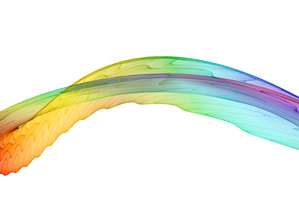'Gaydar' revisited: New insight into how women perceive emotions, thoughts, personality, and sexual orientation

A recent study sheds new light on the phenomenon known as "gaydar," or the ability to determine another person's sexual orientation.
The study found that women who identified as lesbians were better at detecting sexual orientation in other women, but that straight women were more attune to detecting emotion and personality in their peers.
Led by Northeastern University doctoral candidate Mollie Ruben, with assistance from psychology professor Judith Hall and visiting professor of marketing Krista Hill, this isn't the first study to look at "gaydar," but it is one of only a handful to examine it in the specific context of women. Most studies on sexual orientation and perception, the authors write, are focused on males.
Another unique thing about this new study is that it doesn't just look at judgments of sexual orientation, but also of emotions, thoughts, and personality.
To conduct the study, authors filmed interviews with nine target subjects, during which a "confederate" (someone working for the researchers but unaware of the study's purpose) asked questions about family relationships and future plans to draw out emotional responses from the interviewees.
After filming, these targets subjects (four of whom identified as straight, five as lesbian) watched themselves on screen and marked down the emotions and thoughts they experienced at particular time-points during the interview. Collectively, these nine women experienced 7,150 thoughts and emotions during their five-minute interview. The targets also had to fill out a personality questionnaire about themselves and ask a friend to do the same to verify their self-reports.
Next, 100 judges (67 straight women and 43 lesbians) were asked to watch these same videos and at each time-point when the target indicated a feeling or emotion, the judge had to guess what that feeling or emotion was. The judges also had to guess at the targets' personalities. (Such as, does she remain calm in stressful situations? Is she assertive?)
The researchers scored the judges based on four criteria: whether they accurately detected the targets' emotions, thoughts, personality, and sexual orientation. For each criterion, the judges received a collective score for all the targets, as well as separate scores for their accuracy among the straight targets and the lesbian targets.
While the lesbians were better at determining sexual orientation, the straight women were better at assessing thoughts and emotions. They were particularly good at this when the targets they were judging were also straight. Both groups did an equally good job of evaluating personality traits.
Interestingly, the straight targets were generally more transparent (to both straight and lesbian judges) in comparison to their lesbian counterparts. Both groups of judges had a consistently easier time detecting each criterion for the straight women.
The researchers suggest that lesbians may have found it "more interesting, motivating, and rewarding to judge the sexual orientation of other women compared to judging their thoughts, emotions, or personality." Straight judges, they write, might not care so much about sexual orientation and thus don't focus on it enough to do a good job of detecting it.
In the case of judging targets' thoughts (which the researchers call "empathic accuracy"), they wonder if the straight women considered the lesbians as "out-group" (not like them) while the lesbians consider all of the targets to be "in-group." If that's the case, then maybe the straight women were less motivated to empathize with lesbians, while lesbians want to empathize with all of the women.
The authors point out that this experiment has a number of limitations, namely the fact that it took place in Boston, where people are less likely to have conservative thoughts and opinions about homosexuality. Furthermore, the participants were not a random sample. Rather, the women were recruited through friend networks and LGB community websites.
Nevertheless, the study adds a new layer to the concept of "gaydar," and, more importantly, several novel contributions to research on the subject.
More information: Study: www.tandfonline.com/doi/abs/10 … .890093#.Uw5x10JdXSw
*A NOTE ON DETERMINING SEXUAL ORIENTATION: I absolutely love this paragraph from the paper:
" Although sexual orientation is not intrinsically dichotomous, we created a binary sexual orientation variable from the continuos 7-point homosexuality variable. Each judge watched all nine targets and made the continuous homosexuality rating of each target. Judgements of 1 (not at all homosexual) and 2 (slightly homosexual) were grouped as straight while judgements of 3-7 (mildly homosexual, moderately homosexual, significantly homosexual, very homosexual, and extremely homosexual) were grouped as lesbian. All straight targets had selected a 1 (not at all homosexual) and all lesbian targets had selected a 6 or 7 (very homosexual or extremely homosexual) so the target criterion data were grouped in the same way as the judges' perception data."
- See more at: www.northeastern.edu/insolutio … sthash.221S8n3s.dpuf

















